There are a number of reasons gardeners choose to plant shrubs in containers.
A common one is limited space, but potted plants can also be useful if you are looking to grow species that are not well suited to your climate, or simply want the flexibility to move your plants around.
They can also create a nice aesthetic on a patio or deck.

We link to vendors to help you find relevant products. If you buy from one of our links, we may earn a commission.
Continue on to learn all you need to know to grow shrubs in containers.
What You’ll Learn
Growing potted shrubs is not much different than growing them in the ground would be. Planting and growing requirements will be similar in either case.

The main difference is, since they are being planted in a contained space – and potentially spending some time indoors for part of the year as well – you need to pay close attention to make sure their needs for water, sunlight, and nutrients are met.
Species Selection
Many shrubs do well if they are grown in containers, but some may be better suited to your needs and available space than others.
When determining which species to plant, there are a few useful factors to keep in mind:
1. Take Growth Rate into Account
Slower-growing shrubs tend to do well in containers, since they don’t need to be repotted as often, and are less likely to become root bound.
Evergreens such as boxwood, Japanese holly, azalea, or rhododendron make great container plants.
2. Think Small
Dwarf varieties are also great options, since they are naturally smaller and adapt well to small spaces, without the need for significant pruning each year, or the risk of tipping over their containers.
3. Move with the Sun
One nice thing about container plants is that they can be moved around to sunnier or shadier locations, depending on their needs.
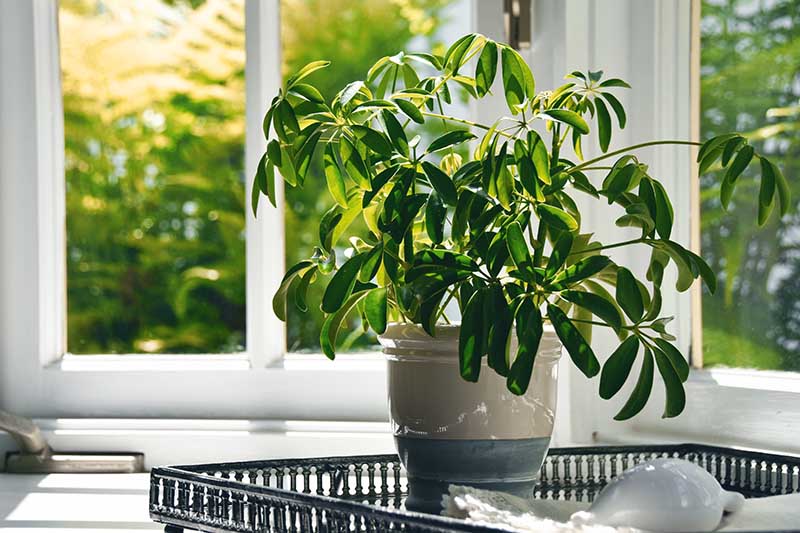
If you plan to keep the pots on a patio, indoors, or you have otherwise limited placement options, pay extra attention to the sun requirements of your selected plant, and choose species and cultivars that are suited to the conditions you can provide.
4. Consider Temperature and Wind Protection
When selecting species for outdoor placement, be sure to consider your hardiness zone.
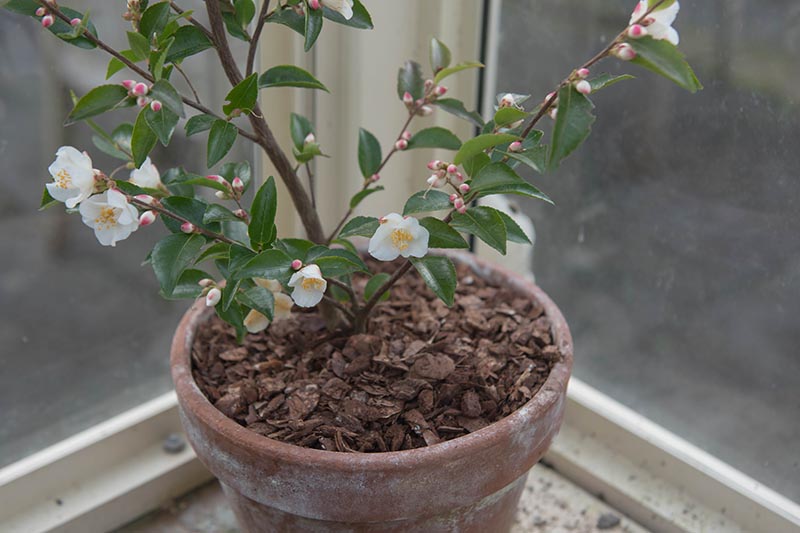
The roots of container plants will be exposed to the temperature of the air around them more readily, since the roots don’t have the benefit of in-ground insulation.
To protect against this, you may either choose species that are hardy to two zones colder than where you live, or plan to bring them inside or protect them during the winter.

Shrubs that are growing in containers outdoors are also susceptible to wind.
If plants will be situated in a windy spot, consider lower growing species, use a heavy and wide container, or place a weight at the bottom of the pot to reduce the risk of toppling.
5. Remember Ornamental Value
Don’t forget about aesthetics! Have fun selecting species that provide beautiful foliage and flowers.
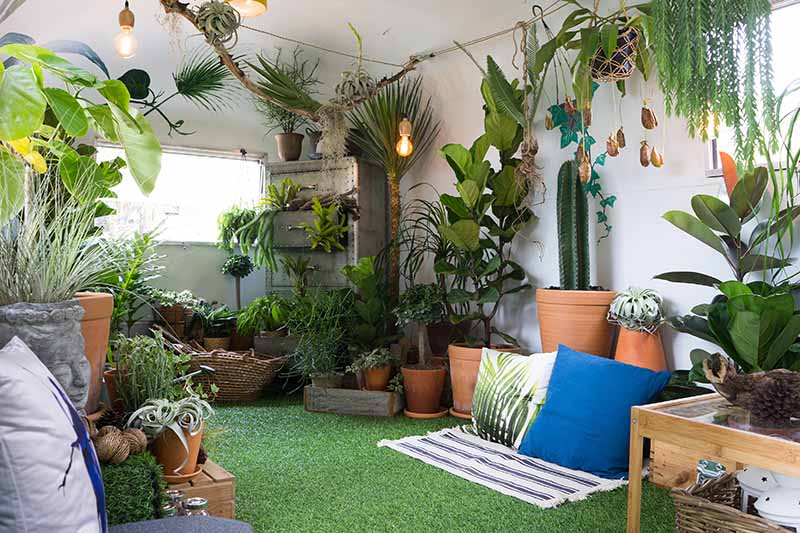
Choose plants with cascading branches to tumble over the sides of the container, or select a tall upright shrub to function as a nice focal point in your space.
Containers also provide so many options.
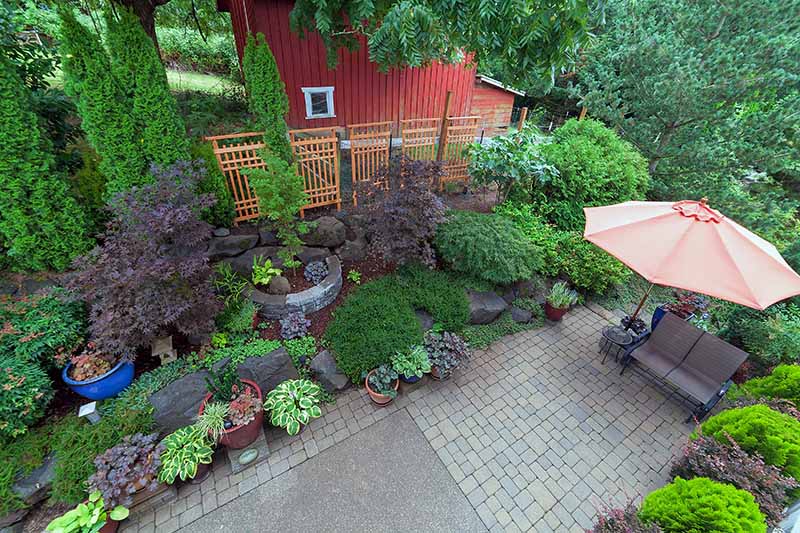
You can mix and match with different planters to create different expressions of your selected aesthetic that pair attractively with your chosen species.
Choose an Appropriate Container
As I just touched on, there is so much variation available in terms of container size, shape, and design.
Options are available for any landscape, and the planters themselves can add to the attractiveness of your design.

Select a pot with good drainage that is the appropriate size and shape for the plant.
It needs to be large enough for the roots to have room to grow, but select one that’s too large and the roots may be susceptible to rot.
Here’s my general rule of thumb:
Look for a pot six to 12 inches larger than the nursery pot the plant came in.

Choice of material is also an important consideration.
If you know you will have to move your plant from season to season, consider a planter that is lightweight, supported by wheels, or placed on a corresponding stand on rolling casters.
Plants that will grow to a tall stature should be placed in pots heavy enough that they won’t tip over in high winds.
Until the shrub reaches maturity, repot in a size up that is a few inches larger every couple of years, sooner if you notice roots creeping out of the drainage holes.
Repotting will give roots more space to grow, reducing the possibility of your bushes becoming stunted.
Keep in mind, however, that repotting certain species – such as Norfolk Island pine – can encourage them to grow beyond their bounds, to a towering height that may no longer fit your space.
Again, keep the growth rate and potential height and spread of your selected plants at maturity in mind, and consider your pot options and need for upsizing accordingly.
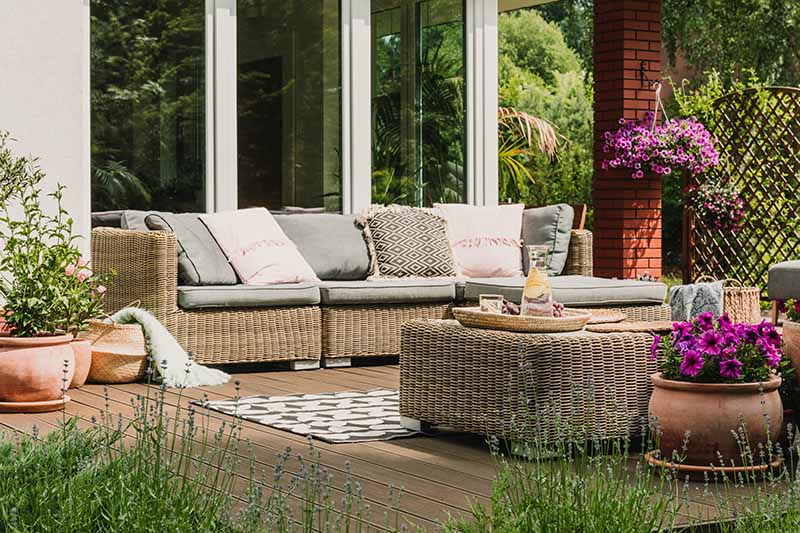
Plants will grow, but your space will not.
You may not want to put a tiny container on a large deck if you are aiming to create a focal point, or you may struggle to function normally through the winter with a giant pot in your living room.
Note the square footage that you have available in your chosen location, measure in all dimensions, and consider nearby plants and furniture as well.
Planting Instructions
After you’ve made your pick and chosen your pot, it’s time to plant!
To plant your shrub, start by lining the bottom of the pot with rocks or porous landscaping fabric, to keep drainage holes from becoming clogged with soil.
Next, remove the plant from the nursery pot and gently loosen the soil around the outside of the root ball.
If the plant is root bound, shake it gently or spray it off with water from the hose to remove some of the soil, and gently pry the roots apart.
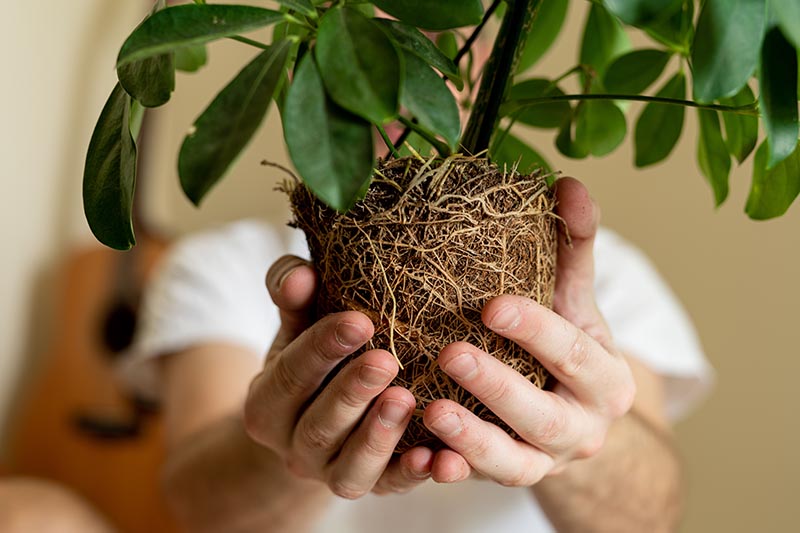
Repot in your chosen container using equal parts potting soil, compost, and sand. Do not use soil from the garden, as it will not drain well enough for container growing, and this could lead to rot.
If planting tropical shrubs, use a soilless mixture, or try replacing the potting soil from the nursery with shredded pine bark.
Sprinkle a layer of the potting medium at the bottom of the pot, and set the plant on top. Add or remove potting material as necessary, to settle the top of the roots about an inch below the rim.

Once the plant is set, add more potting mix around the roots, tamping it down as you go to remove air pockets.
The final soil level should be even with the top of the roots, covering them.
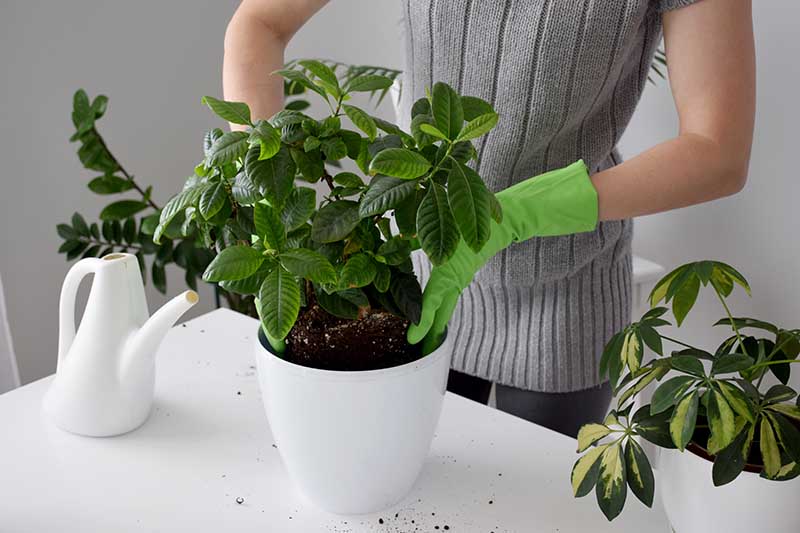
Top with 1/2 inch of wood chips, moss, compost, or crushed rocks to help insulate the shrub, protect the soil, and conserve moisture.
Water thoroughly, until you see water leaking out the holes in the bottom of the pot.
General Maintenance
Once your plant is settled into its new home, keep the following care tips in mind.
Create a schedule, so your new shrub will become established nicely in its container, and to ensure that it stays healthy and happy.
Watering
Determining how often to water will vary depending on the species and the season.
In general, it’s best to water when the top couple of inches of soil feels dry. Soak the potting medium thoroughly, until water drips out the drainage hole.
Let it dry out completely before adding more water.
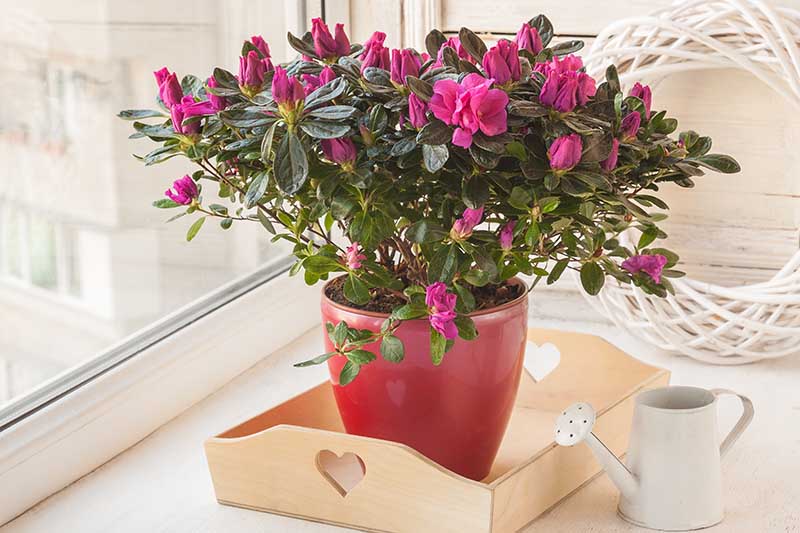
Shrubs that are growing in containers tend to dry out more quickly than in-ground plants.
During hot and sunny summer weather, this could mean they need water daily. In the winter, they may be able to go two or three weeks between waterings.
Fertilizing
Because potted shrubs are planted in a contained environment, they don’t have access to the expansive and abundant supply of nutrients often present in the ground.
For this reason, they could use a helping hand to make sure they continue to have all they need to stay healthy and strong.
Specific fertilization needs vary by species.
You may choose to sprinkle a slow release granular fertilizer around the surface of the soil at the beginning of the growing season, or feed with a dose of liquid fertilizer every week or two.
I recommend choosing an organic liquid fertilizer to avoid burning plants, and reduce the risk of salt accumulation.
Do not fertilize plants during winter dormancy.
Pruning
It is important to prune shrubs regularly, to encourage healthy growth.
During winter dormancy, use pruning shears to remove any dead, diseased, or damaged branches.

If you have a small space or want to keep a potted shrub small for aesthetic reasons, you can prune branches as desired.
Or, you may use a technique called root pruning to keep shrubs from growing too large.
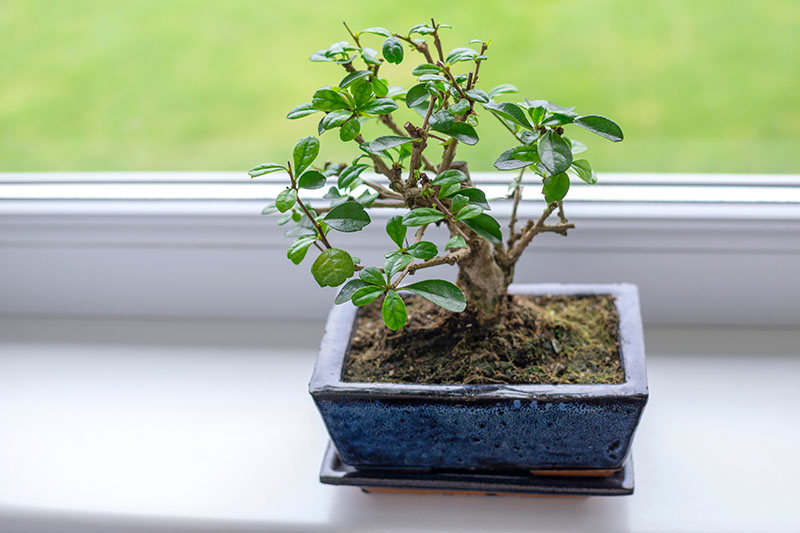
To do this, remove the entire plant from its pot, and carefully pull apart and trim the feeder roots, cutting no more than a third of them at a time.
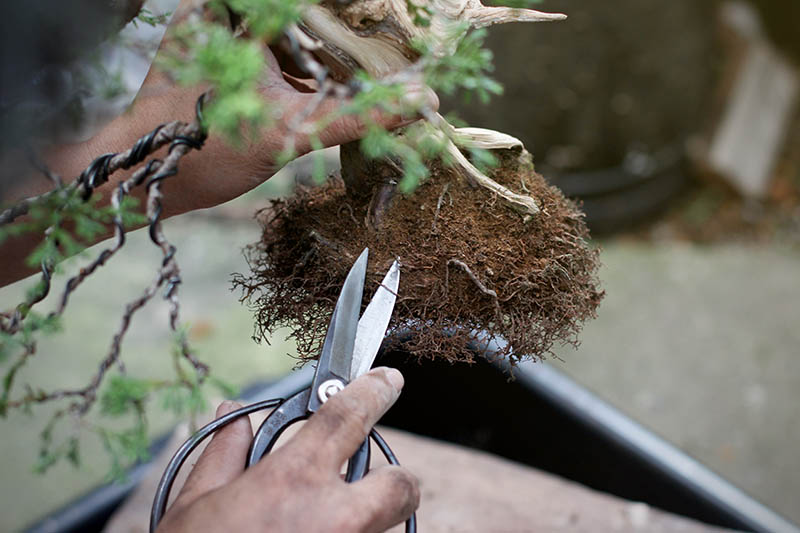
Avoid cutting tap roots, and be gentle with this process, as cutting roots will temporarily weaken the plant. Repot in the original container, replace the soil, and water well.
You can root prune every couple of years, or whenever the shrub becomes root bound.
Protecting from the Elements
Since the sides of containers are exposed to ambient air temperatures, the roots of potted plants are much less insulated than roots protected by the ground.
If air temperatures dip, the soil in containers can freeze completely. So it is important to take extra steps to protect your potted shrubs from wintry weather.
When temperatures drop, you can bring pots inside, bury them in the ground and cover the bushes with mulch, or place them in a protected space like a basement or garage.
For more detailed information about ways to do this, read more about protecting potted trees in this article.
Hardening Off Sensitive Shrubs
Any time when you are moving plants that have been indoors for the winter back outside, make sure to harden them off first.
This simply means setting them outside in a protected shady spot for a couple of hours a day, starting with about an hour and gradually increasing the length of time each day to follow.
Then, move the container to a spot with more direct sun, and increase the time spent there gradually as well.
After a couple of weeks, hardened off potted bushes are ready to be moved back to their permanent outdoor location.
Grow a Bounty of Potted Bushes for Limitless Possibilities!
There are so many reasons to incorporate container-grown shrubs into your landscape.
Whether you are looking to spice up the patio area, maximize the utility or attractiveness of minimal space, or add color and dimension to the mix, potted bushes are absolutely worth considering.
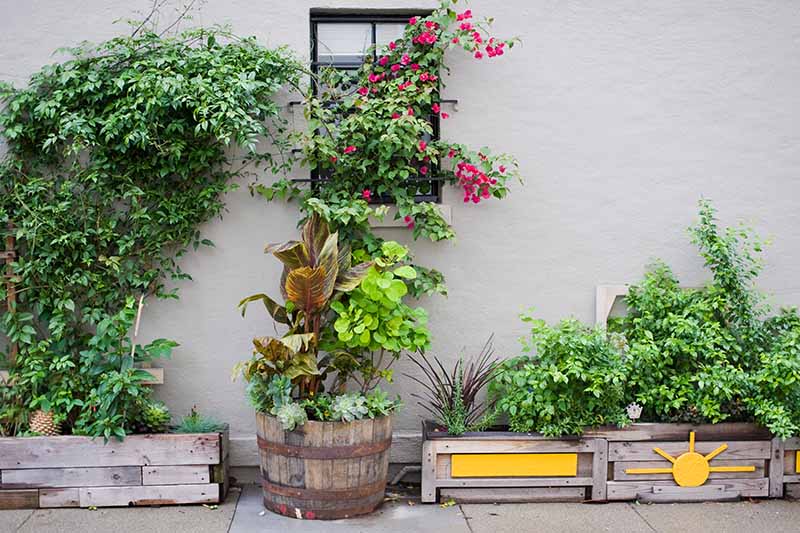
The process of planting and growing them is so easy, and your options are virtually limitless!
Follow the tips provided here, and remember to pair this with a little research to determine the unique and specific needs of your chosen species. Our guides to growing woody shrubs can help.
What are your tips for growing shrubs in containers? Have you had success with certain species? Share your thoughts in the comments below!
Excited to learn more about container gardening? Check out these articles next for more great ideas for growing plants in pots:
- Keep Your Containers Looking Great With These 6 Simple Tips
- How to Grow Vegetables in Containers
- 9 Must-Have Succulent Planters
© Ask the Experts, LLC. ALL RIGHTS RESERVED. See our TOS for more details. Uncredited photos: Shutterstock. With additional writing and editing by Allison Sidhu.




Will cypress grow in a container in zone 5
Hello Karen! Yes, cypress trees are a good option for container trees in zone 5. They’re especially helpful if you’re trying to establish a privacy fence but don’t want to plant trees in the ground at a rental or for some other reason. Just remember that cypress do get rather tall, especially if you don’t practice root pruning. So they’ll need larger containers than most, which can be heavy and expensive, and tough to move around. Also, all container trees need extra water and fertilizer. If you’re up for the extra effort, cypress grows well in containers. Good luck, whatever… Read more »
Can Spintop Starburst be kept in a container until I sort out the best permanent home for it? Please
Blanket flowers can do beautifully in containers! Whether or not this is just a temporary stopover, I generally recommend that all live plants be removed from their nursery pots and transplanted into something a touch larger, with excellent drainage and fresh soil added. This will allow you to check the health of the roots as well, and give them a bit of room to stretch. Read more about growing gaillardia in our guide.